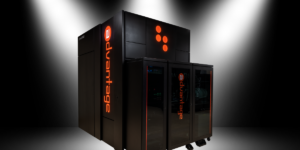
USC’s Information Sciences Institute recently opened a new office in Greater Boston (Photo/iStock).
For more than four decades, the USC Information Sciences Institute (ISI) has made an outsize contribution to advancing information processing, computer and communications technologies.
ISI, a unit of the USC Viterbi School of Engineering and one of the nation’s most impactful university-affiliated computer research institutes, helped create the protocol architecture of the Internet; invented and developed the Domain Name System (.com, .net, etc.); and features the gold standard of cybersecurity groups in DETERLab. Its areas of expertise include intelligent systems, such as natural language, and machine translation; informatics focused on medical applications; novel electronics; and high-performance computing, including quantum techniques.
ISI’s distinguished past notwithstanding, the institute’s present and future hold even more promise. As it prepares to celebrate its 45th anniversary, ISI has attracted more government funding for more major projects in the last couple of years than at any time in its history. In 2016 alone, research awards exceeded $100 million in federal dollars.
Under the leadership of Prem Natarajan, a former executive vice president and principal scientist at Raytheon BBN Technologies, ISI has also just opened a new office in Greater Boston to complement its facilities in Marina del Rey and Northern Virginia.
“ISI researchers today drive revolutionary advances in areas ranging from machine learning and artificial intelligence to cybersecurity, from novel electronics to high-performance computing architectures and quantum computing, and from health informatics to forecasting of societal and cyber events,” Natarajan said.
Added Dean Yannis C. Yortsos: “Through its 40-plus years of history, ISI has not only been the crown jewel of USC Viterbi, but more importantly a national asset in information sciences. Prem’s outstanding leadership, decision making, national stature and vision have now elevated the Institute to yet higher levels.”

ISI’s Prem Natarajan (Photo/USC Viterbi Library)
Among the ISI-led projects to have received major government funding in 2016:
- Rapid Analysis of Various Emerging Nanoelectronics program (RAVEN). IARPA awarded ISI $30.9 million to develop tools capable of imaging even the smallest of features in modern silicon integrated chips to ensure they are free of defects. ISI’s John Damoulakis will lead the team, which includes researchers from Stanford and Northwestern universities, among other institutions.
- SIGINT-based Anticipation of Future Events (SAFE). ISI received $6 million for the first phase of a research effort to devise techniques for generating probabilistic warnings of future events, such as terrorism; optional future phases could double research funding, bringing the total to $12 million. Researchers plan to develop feature extraction and prediction methods that leverage explorations of graph-based models, causal modeling and probabilistic fusion. ISI’s Prem Natarajan and Aram Galstyan, both computer science research professors at USC Viterbi, lead a project team that includes researchers from Harvard, Northeastern and Virginia Tech universities.
- GenitoUrinary Development Molecular Anatomy Project (GUDMAP). The National Institutes of Health awarded ISI $725,000 plus a $2.8 million option to help researchers better share information about congenital anomalies of the kidney and urinary tract. The project, headed by ISI’s Carl Kesselman, a USC Viterbi professor in industrial and systems engineering, aims to advance research in urogenital development through the creation of a data-sharing infrastructure available to medical researchers.
- Effectively Forecasting Evolving Cyber Threats (EFFECT). IARPA awarded ISI nearly $6.5 million plus an $8.8 million option to better forecast emerging cyber threats by integrating information from a variety of novel sensors. ISI’s Kristina Lerman, a USC Viterbi research associate professor of computer science, and ISI co-leaders Craig Knoblock, a computer science research professor, and Stephen Schwab, will collaborate with researchers from Arizona State, Raytheon BBN and Lockheed Martin, among others, to address several technical and scientific challenges, such as finding traces of early cyber-attack planning, despite attempts to hide them in so-called “dark web” forums.
- Digital, Semantic and Physical Analysis of Media Integrity (Disparity). DARPA awarded ISI more than $8.3 million to develop ways to automatically detect manipulated digital media, including images and videos. Headed by ISI’s Prem Natarajan and Wael Abd-Almageed, partners include the University of Naples and the University of Erlangen-Nuremberg.
As ISI’s federal funding has increased, so, too, has the institute’s talent pool and geographical footprint.
In February, ISI opened a new office in Greater Boston with six new senior researchers and one visiting researcher. Over the next four years, Natarajan said, ISI hopes to staff up the Waltham office to 15 senior researchers. Areas of emphasis will include quantum information processing; information extraction and retrieval; and computer vision.
“Boston produces lots and lots of research talent across the spectrum, from medical and life sciences to engineering, science and technology. In general, it’s a very fertile ground for recruiting research talent,” said Natarajan, who attended graduate school at Tufts University and worked at Raytheon BBN, both in Greater Boston. “Being there also allows us to build relationships with top research organizations in those locales.”
Added Dean Yortsos: “ISI’s new office in the greater Boston area will now expand ISI’s footprint to areas with considerable new talent bases and will help solidify its national reach and importance.”
Among the talent that has joined the Boston office:
- Scott Miller: An ISI research team leader, Miller has more than three decades of experience in natural language processing, machine translation and information extraction.
- Jonathan Habif: Habif, a research lead at ISI, is an expert in quantum information processing who focuses on exploiting quantum phenomena for secure and energy-efficient communication. At ISI, he will build an experimental lab in quantum information processing.
- Elizabeth Boschee: A former BBN lead scientist, ISI research lead Boschee is an expert in natural language processing, with a focus on developing information extraction techniques for computational social science and forecasting.
In a reflection of ISI’s growing reputation, IARPA earlier this year awarded the institute a $5.2 million grant, with an $8.3 million option, for the Biometric Authentication with Timeless Learner program, or BATL. A research team led by ISI’s Wael Abd-Almageed will develop inexpensive algorithms to improve security for fingerprint- and face-based authentication systems.
“This is, without question, the most exciting time ever to be a researcher in the information and computing sciences,” Natarajan said. “It is also a tremendously exciting time to be at ISI and a privilege to serve as the standard bearer of such an organization.”
Published on July 12th, 2017
Last updated on February 11th, 2021













